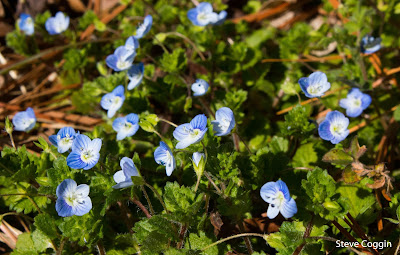 |
| Bird's Eye Speedwell (Veronica persica). A small, early spring wildflower from our yard. Rowan County, North Carolina. |
Spring is upon us and in our yard delicate wildflowers are popping up and blooming. Our lawn is not a smooth monoculture of Bermuda grass. The lawn does have some grass but it also has lots of wildflowers, that is weeds. A definition of a weed is "a plant that is growing where someone does not want it". Lots of plants that we call weeds are adapted to living in disturbed habitats. Our lawns and roadsides mimic the natural environment where these plants thrive.
 |
| Flowers and fruits of Cardamine hirsuta, Hairy Bittercress. Rowan County, North Carolina. |
An early and dainty wildflower is Cardamine hirsuta, Hairy Bittercress. This small plant has flowers with flower parts
in fours including its white petals. The
fruits of Hairy Bittercress, called siliques, are cylindrical and contain a
single row of tiny seeds. Cardamine hirsuta is in the family Brassicaceae, a group that includes many important vegetables
including mustard, cabbage, broccoli and turnips. Hairy Bittercress is native to Europe and has
spread around the world, including much of the United States.
 |
| Flowers of Hairy Bittercress with their four petaled flowers. Rowan County, North Carolina. |
Two other early lawn weeds are in the mint family, the
Lamiaceae. Lamium purpureum (Red-dead Nettle) and Lamium amplexicaule (Henbit) are both small herbaceous plants that
make hooded, purple flowers. Lamium flowers are bee pollinated and
provide nectar for the early emerging insects. The common name, Red-dead Nettle, refers to the superficial resemblance of Lamium
purpureum to true nettles in the genus Utrica. However, Lamium
purpureum does not sting, hence the name dead-nettle. Both
these species of Lamium are found
throughout North America but originated in Eurasia.
 |
| The mint Lamium purpureum or Red-dead Nettle. Rowan County, North Carolina. |
 |
| A large stand of Henbit, Lamium amplexicaule. Rowan County, North Carolina. |
Our yard is graced by two species of Veronica in early spring. The common name of Veronica is Speedwell and they are classified in the plantain family, the Plantaginaceae. Veronica hederifolia, Ivy-leafed Speedwell is a small plant with tiny blue flowers. Veronica persica, Bird’s-eye Speedwell, flowers are a little larger than the Ivy-leafed Speedwell and are also blue. Both these Speedwells have darker blue lines on the petals called nectar guides. Insect pollinators like bees can see ultraviolet and these lines are dark ultraviolet arrows pointing to the flower’s nectary. As the bee is sipping nectar it picks up pollen and takes it to the next Veronica flower. Both Speedwells were introduced to North America from Eurasia.
 |
| Ivy-leafed Speedwell, Veronica hederifolia. Rowan County, North Carolina. |
 |
| Veronica persica, Bird's-Eye Speedwell. This species has larger flowers than the Ivy-leafed Speedwell. Rowan County, North Carolina. |
The white flowers of Common Chickweed (Stellaria media) also appear in spring. Common Chickweed flowers have five petals but because each petal is two-lobed the flowers appear to have ten petals. Stellaria media is in the Caryophyllaceae, the same family as carnations. Chickweed is native to Asia and Europe and can be eaten raw in salads or cooked like spinach.
 |
| Common Chickweed, Stellaria media, with its tiny white flowers. Rowan County, North Carolina. |
Sow Thistle, Sonchus
oleraceus, like our native thistles, is classified in the Asteraceae, the
sunflower family. It is yet another
spring weed that was introduced from Eurasia.
Sow Thistle grows in disturbed habitats. This plant is highly nutritious and eaten by people and
pigs alike. The flowers of Sow Thistle are
yellow and resemble those of Dandelion (Taraxacum officinale).
The fruits of Sow Thistle are also like those of Dandelion and are dispersed on
the wind.
 |
| Sonchus oleraceus, Sow Thistle growing beside a road in my neighborhood. This member of the sunflower family is originally from Eurasia. Rowan County, North Carolina. |
 |
| Close up of flowers and fruits of Sow Thistle. The fruits of this plant can fly on the breeze. Rowan County, North Carolina. |
Azure Bluet (Houstonia
caerulea) has delicate blue flowers with four petals and a yellow center. Houstonia
caerulea is a member of the Rubiaceae, a family that also contains the
plants that give us coffee beans and quinine. Unlike the other wildflowers already
discussed in this blog, Azure Bluets are native to North American being found from
Eastern Canada to the southern US.
 |
| Azure Bluet, Houstonia caerulea growing in a lawn. Rowan County, North Carolina. |
A whole segment of the chemical industry is devoted to
developing and selling weed killers. We
never apply them to our “lawn”. After all, our yard is mostly weeds, or wildflowers.




